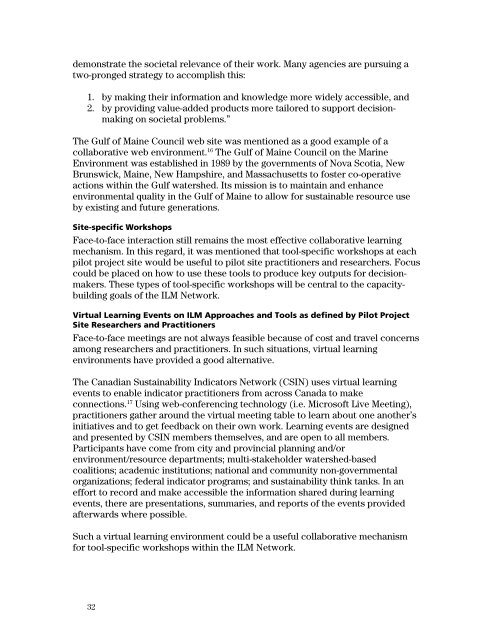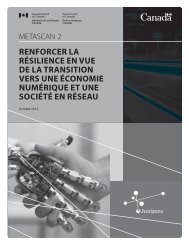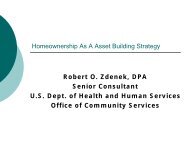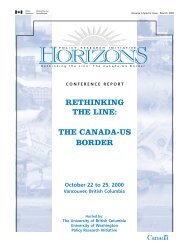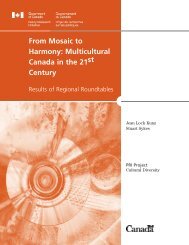PDF Format
PDF Format
PDF Format
You also want an ePaper? Increase the reach of your titles
YUMPU automatically turns print PDFs into web optimized ePapers that Google loves.
demonstrate the societal relevance of their work. Many agencies are pursuing a<br />
two-pronged strategy to accomplish this:<br />
1. by making their information and knowledge more widely accessible, and<br />
2. by providing value-added products more tailored to support decisionmaking<br />
on societal problems.”<br />
The Gulf of Maine Council web site was mentioned as a good example of a<br />
collaborative web environment. 16 The Gulf of Maine Council on the Marine<br />
Environment was established in 1989 by the governments of Nova Scotia, New<br />
Brunswick, Maine, New Hampshire, and Massachusetts to foster co-operative<br />
actions within the Gulf watershed. Its mission is to maintain and enhance<br />
environmental quality in the Gulf of Maine to allow for sustainable resource use<br />
by existing and future generations.<br />
Site-specific Workshops<br />
Face-to-face interaction still remains the most effective collaborative learning<br />
mechanism. In this regard, it was mentioned that tool-specific workshops at each<br />
pilot project site would be useful to pilot site practitioners and researchers. Focus<br />
could be placed on how to use these tools to produce key outputs for decisionmakers.<br />
These types of tool-specific workshops will be central to the capacitybuilding<br />
goals of the ILM Network.<br />
Virtual Learning Events on ILM Approaches and Tools as defined by Pilot Project<br />
Site Researchers and Practitioners<br />
Face-to-face meetings are not always feasible because of cost and travel concerns<br />
among researchers and practitioners. In such situations, virtual learning<br />
environments have provided a good alternative.<br />
The Canadian Sustainability Indicators Network (CSIN) uses virtual learning<br />
events to enable indicator practitioners from across Canada to make<br />
connections. 17 Using web-conferencing technology (i.e. Microsoft Live Meeting),<br />
practitioners gather around the virtual meeting table to learn about one another’s<br />
initiatives and to get feedback on their own work. Learning events are designed<br />
and presented by CSIN members themselves, and are open to all members.<br />
Participants have come from city and provincial planning and/or<br />
environment/resource departments; multi-stakeholder watershed-based<br />
coalitions; academic institutions; national and community non-governmental<br />
organizations; federal indicator programs; and sustainability think tanks. In an<br />
effort to record and make accessible the information shared during learning<br />
events, there are presentations, summaries, and reports of the events provided<br />
afterwards where possible.<br />
Such a virtual learning environment could be a useful collaborative mechanism<br />
for tool-specific workshops within the ILM Network.<br />
32


